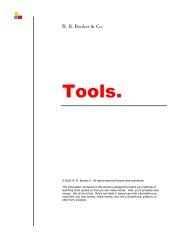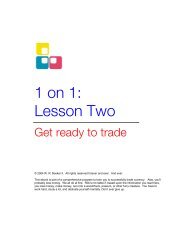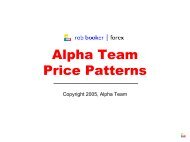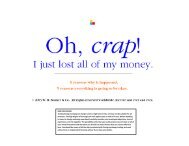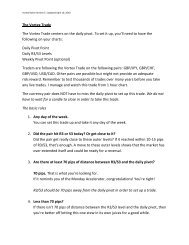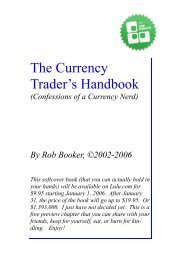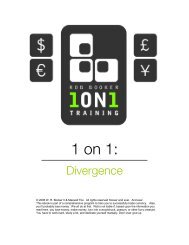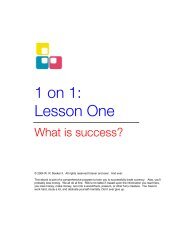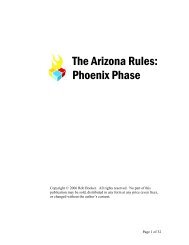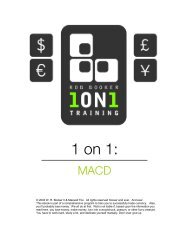Create successful ePaper yourself
Turn your PDF publications into a flip-book with our unique Google optimized e-Paper software.
<strong>Fibonacci</strong><br />
Part I<br />
By <strong>Rob</strong> <strong>Booker</strong><br />
© 2004 W. R. <strong>Booker</strong> II. Forever rights reserved and ever All. And ever.<br />
The information contained in this ebook involves math. Sorry.
<strong>Fibonacci</strong> Part I – page 2<br />
<strong>Fibonacci</strong> <strong>Numbers</strong>: Part 1<br />
________________________________________<br />
The use of <strong>Fibonacci</strong> numbers in your trading can be a powerful asset.<br />
For most traders, the meaning of these numbers, and their use, are either<br />
misunderstood or left unused. This is a shame. You’re going to add the<br />
power of these numbers to your toolbox – and you should start by getting a<br />
good background in these numbers.<br />
Leonardo Pisano (or “<strong>Fibonacci</strong>”, as he is now called) discovered a<br />
mathematical sequence of numbers with predictive value throughout<br />
nature. Fib numbers start with 0 + 1 and then progress by adding the last<br />
two numbers in the sequence as follows:<br />
0 + 1 = 1 1 + 1 = 2<br />
So 1 and 2 are two of the first Fib numbers (0 is also a Fib number).<br />
Continuing down the line by adding the last two numbers in sequence<br />
leads to the following line of numbers:
<strong>Fibonacci</strong> Part I – page 3<br />
1, 2, 3, 5, 8, 13, 21, 34, 55, 89, 144<br />
And so on. The numbers themselves, although fascinating to study in<br />
nature (just look up <strong>Fibonacci</strong> on Yahoo! or Google), really get interesting<br />
in forex charting when you start talking about their ratios.<br />
A prominent ratio develops from these numbers, simply by taking the<br />
ratio of two successive numbers and then dividing each by the number<br />
before it. This ratio is, roughly:<br />
62%<br />
The other ratios that develop, and that are important for the purpose of<br />
charting, are 38% and 50%.<br />
It’s important here not to complicate the issue. There is a ton of<br />
mathematics backing this up, with long histories of the numbers, of<br />
<strong>Fibonacci</strong> himself, of applications in nature, etc. There are even charting<br />
packages and signal providers that base everything they do on Fib numbers<br />
and ratios. But instead of complicating the issue, I want to leave it right<br />
here. Just remember that there are a few very important ratios that arise<br />
from Fib numbers, and that you can use those ratios to predict price<br />
movement, especially on pullbacks, but also on trends.<br />
Here are some readings on Fib numbers if you want a more<br />
comprehensive (and complex) background:<br />
http://www.mcs.surrey.ac.uk/Personal/R.Knott/<strong>Fibonacci</strong>/fibnat.html#golden<br />
http://www.moneytec.com/forums/_showthread/_s-<br />
55be7400a99aaa355dc59542adcb50eb/_threadid-2459<br />
The power of using <strong>Fibonacci</strong> numbers in charting is best realized on<br />
strategies that concentrate exits and entries based on price pullbacks.<br />
This is because you can use Fib tools to not only ascertain good entry<br />
points, but exit points – because Fib analysis can be one of the more<br />
accurate methods of determining price projections.<br />
Do you have to use them? No. Tomorrow’s lesson will cover how to<br />
draw them, and how to use them – and then it’s up to you. I’d say that 50%
<strong>Fibonacci</strong> Part I – page 4<br />
of the traders I work with use them for some part of their daily analysis<br />
and study.



